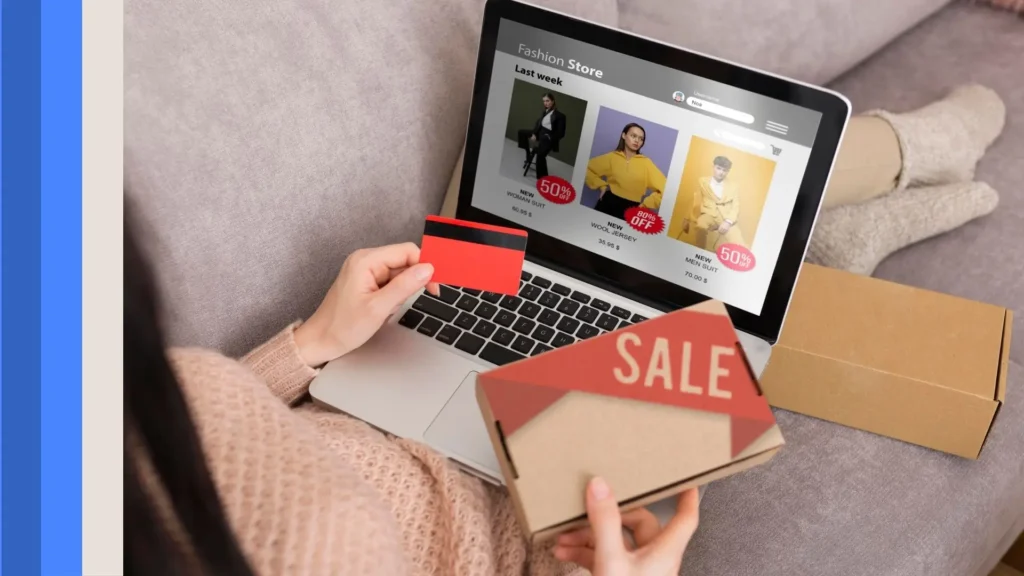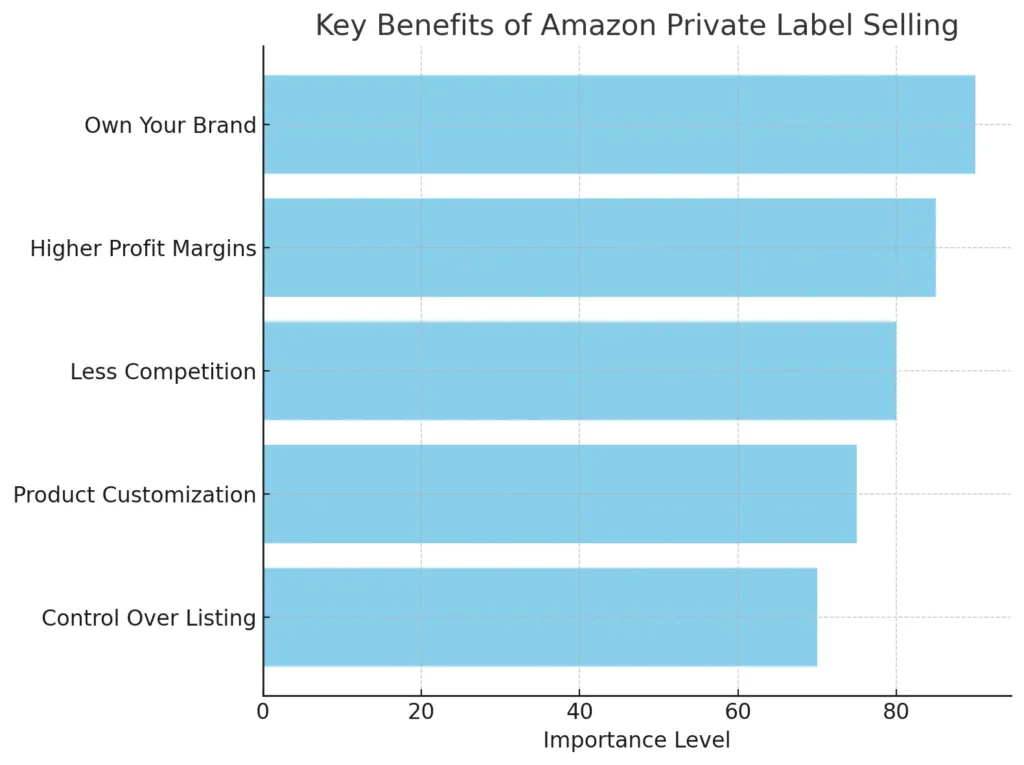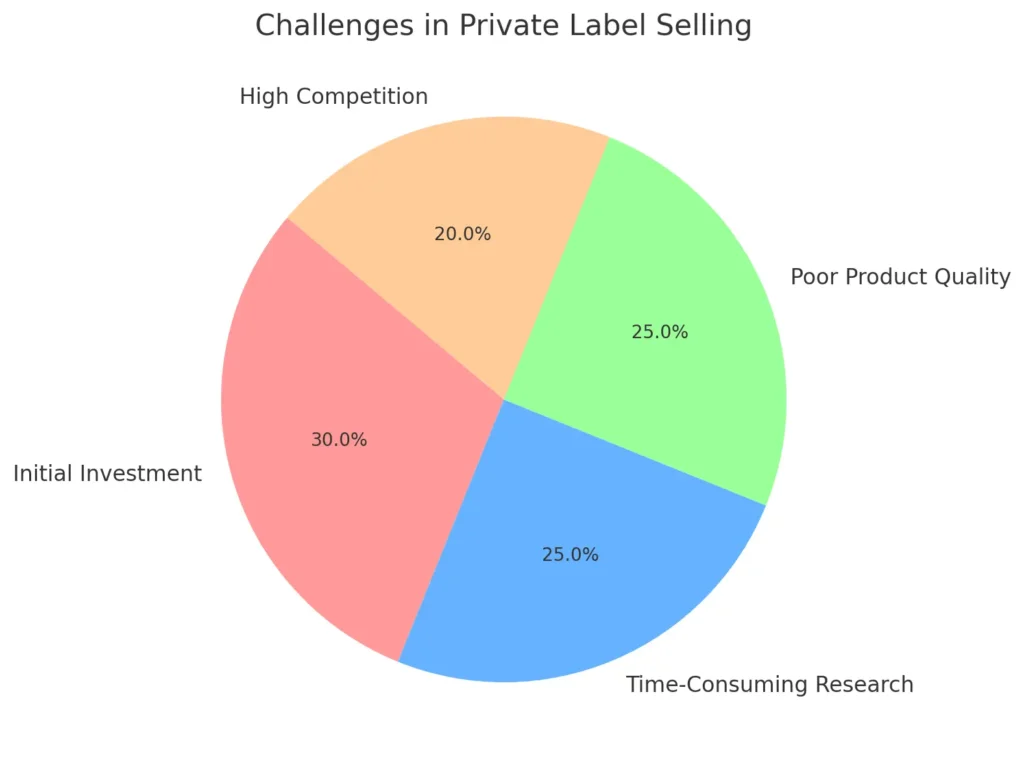Amazon private label involves selling products manufactured by a third party but branded and packaged under your own custom brand. This model allows sellers to control pricing, design, and marketing while building a unique brand identity. It’s one of the most profitable strategies on Amazon due to higher profit margins, less competition, and long-term scalability.
- Why You Should Start Selling Private Label Products on Amazon
- What is the Meaning of Selling Private Labels?
- 5 Key Reasons to Sell Private Label Products on Amazon
- Advantages of Sales of Private Label Products
-
A Simple Guide to Selling Private Label Products on Amazon
- Step 1: Marketing Research
- Step 2: Select a Profitable Product
- Step 3: Identify a Supplier
- Step 4: Build Your Brand
- Step 5: Open a Seller Account on Amazon
- Step 6: Create Your Product Listing
- Step 7: Ship Inventory To Amazon (FBA)
- Step 8: Introduce Your Product to the Market
- Step 9: Oversee and Optimize
- Challenges to face
- Conclusion
- Frequently Asked Questions (FAQs)
Why You Should Start Selling Private Label Products on Amazon
Making money on Amazon has countless variations, whether it is reselling, drop shipping, wholesaling, and so on. Oppositely, though, it is agreed that one of the best and profitable strategies is private labeling, particularly, in the perspective of the success in the long run. In this guide, you will be taught the reasons that make the selling of a private label one of the clever business models and how to begin with nothing.
What is the Meaning of Selling Private Labels?
Selling in the private label format means that you are buying a product that is already produced by a manufacturer and Relabeling it to claim the product ownership. When you are using a retail or online arbitrage to sell your products you are selling products using a brand name, in private labeling you have the freedom of choosing the brand naming, pricing and marketing of your products. This can enable you to develop your own identity business wise as well as manage all its customer experience.
5 Key Reasons to Sell Private Label Products on Amazon
1. You Have Control over your Brand
Retail of a private label implies that the brand and the product are yours. You do not re-sell any person goods with his or her logos or package. Such freedom gives you liberty to determine how your product appears, the name, marketing and the price of your product.
You will not be obliged by the pricing policy and the promotion quota owned by another person. It is your choice all the way- you make your business more flexible and independent.
2. Improved Profit Margin
Cost efficiency has been among the greatest benefits of the private labeling. You also pay less since you are purchasing first hand goods as opposed to distributors and wholesalers. The lesser the costs, the greater the profit margins.
Additional selling methods like wholesaling tend to have additional numbers of fees and middle men. Under the concept of private labeling, you get to retain more profits as you make and own the product end to end.

3. The Right to have Your Product a Way You Want it to Be
Private labeling will ensure that you can vary, develop and pattern your product in the way you desire. That is a great plus compared to reselling where you are required to sell a product as it is.
You may review other competitors to find out what purchase users do not like and create your version to be even better. It could be better packaging, thicker material or something extra. Such type of product enhancement may also enable your variant to be more prominent in market.
4. It Controls the Product Listing on You
Being the original owner of a personal label product, you access the listing of Amazon products fully. It means that you are able to:
- Insert your own pictures
- Write product persuasive writing
- Enter strong keywords
- Price yourself in your own way
This is the freedom of creativity that will make your product rank higher and transform the visitors into customers. When you are merely re-selling something that another person made, then you cannot do these, which restricts your options to stand out.
5. There is no Buy Box Competition to Worry About
The button in Amazon that lets buyers add to cart or buy now is the Buy Box. There is a control over this spot when there are many sellers of the same products and they compete to access this position; winner takes it at the moment.
The problem is not faced by the private label sellers. Because you are the sole seller of your branded product, you gain the Buy Box automatically and this results in increased visibility and sales.
Advantages of Sales of Private Label Products
In case you ever asked yourself, is it worthwhile doing private labeling it is time to show you some of the key advantages that will make you consider it pretty wise option:

Product Customization: You determine the appearance and the functionality of the product.
Brand Building: Build a known name and trust of customers.
Low Competition: There is no other seller in your product.
Higher profit: You will get more money when you have a distinctive price and can charge more.
A Simple Guide to Selling Private Label Products on Amazon
We are going to go through the steps to show you how to get going with creating your own Private Label brand on Amazon.
Step 1: Marketing Research
Begin with determining what people have already purchased and popular products. Apply such tools as:
- Jungle Scout
- Helium 10
The Amazon page of Best Sellers
Keep an eye out on items that:
- Their demand is high (1000+ sales/month)
- Low competition (less reviews)
- Simple and not fragile
Step 2: Select a Profitable Product
The objective of yours is to discover an item which falls under some criteria:
- Ranging at a price of $15 to $50
- Less mass and movable (Low transportation cost).
- Is modifiable or customizable
- Sells not only during a season but all year round
Examples include Bamboo toothbrush, reusable silicone bags, or collapsible storage bins.
Step 3: Identify a Supplier
After identifying a product, next you have to seek someone to produce the product. The platforms that will be considered are:
- Alibaba
- Ali Express
- Global Sources
This is how you have to act:
- Reach out to at least 3 5 suppliers
- Ask the samples of the products to compare the quality
- Negotiate prices, delivery time, and quantities of minimum orders
- Get a sweet deal Negotiate a sweet deal
- Also request the supplier whether they have customization and packages of the products.
Step 4: Build Your Brand
- Identify and shape your product’s identity.
- Choose a memorable brand name
- Make a logo with Canva or get a freelancer on Fiverr.
Step 5: Open a Seller Account on Amazon
Access Amazon Seller Central to set up your seller profile. You can pick one of the following options:
- Individual Account: For people that sell less than 40 times a month.
- Professional Account: $39.99/month, for frequent sellers.
Choose a fulfillment option between the two following:
- FBA (Fulfillment by Amazon): They will pack, ship and do returns on the products sold.
- FBM (Fulfillment by Merchant): You handle shipping and everything else relating to sales.
Most new sellers prefer FBA due to its ease of use and reputation.
Step 6: Create Your Product Listing
Your Amazon listing serves as your product’s store; thus it is crucial that it is well designed.
In addition,
- title should contain abundant keywords
- Include more pictures displaying the product in a practical situation
- Key benefits stated in bullet points.
- Description must be concise using HTML formatting.
- Relevant baseline indexes obtained through research instruments.
HTML aids with enhancing listings so this feature greatly helps with visibility for both ranking and conversions.
Step 7: Ship Inventory To Amazon (FBA)
After preparing items add these steps to ready them for shipment to an amazon’s fulfilment center:
- Label each item using the FNSKU barcode
- Use proper packaging according to amazon standards.
- Make a shipping plan from your account on seller central.
- Ship stock to their warehouse
They are responsible for storage and distributing during sale periods.
Step 8: Introduce Your Product to the Market
Now you can begin to see sales and growth. To increase your product’s visibility:
- Provide special discount offers, promo codes or coupons.
- Utilize Amazon PPC ads (Pay-Per-Click)
- Promote Reviews Through Amazon Vine and Other Eligible Programs
- High quality reviews during this phase build trust and boost sales in the future.
Step 9: Oversee and Optimize
Product launch requires continuous monitoring. Make sure that you:
- Monitor advertising engagement metrics
- Control inventory
- Attend to client’s suggestions
Adjust your product listing along with its keywords if necessary. Build more products with private labeling under the same niche to diversify your brand.
Challenges to face
1. Initial Investment
Beginning a private label venture usually incurs significant costs. To minimize risk, start with a modest-sized order and reinvest earnings to enable further scaling.

2. Research That Requires a Significant Amount of Time
It can be time consuming to find a particular product. You can expedite this process by leveraging tools like Jungle Scout or Helium 10 for trend and competition analysis.
3. Low Supplier Standards
There is always the danger that suppliers will send low-quality goods. Always evaluating samples before bulk purchases protects from this danger.
4. Over Saturation in The Marketplace
Most categories on Amazon have an overwhelming number of sellers; you can get around this by narrowing your selection to less competitive niche products, focusing on adding value through differentiation or additional features.
Conclusion
Private labeling on Amazon can be highly profitable, providing opportunities to build an online business. You are able to create something personal to yourself, manage your brand, and have the opportunity to make profit.
Through careful research, quality sourcing, robust marketing strategies, and dedication during the weekends ensures that private label sellers can transform basic products into high-end selling items. It is certainly an uphill battle at first; however, in the long-run it offers a plethora of benefits.
Frequently Asked Questions (FAQs)
Around $1000-$3000 serves as a good baseline budget that encompasses product fright and orders, shipping, branding campaigns and advertisement initiatives.
Yes you can; however if you intend on registering your brand with amazon (Brand Registry), then a trademark would be necessary.
Definitely yes; Just ensure that items which you intend on selling will not breach any patents or copyrights.
To properly evaluate demand, competition along with profit margins some of the most useful tools include ‘(Jungle scout)’, ‘(helium 10)’ ,and ‘(AMZSCOUT)’.





